osu!mania mapping guide
Prologue
What is osu!mania?
Main page: osu!mania
osu!mania is one of the four game modes. osu!mania falls under the genre Vertical Scrolling Rhythm Game (VSRG). As the name already suggests, that the musical notes are falling down or rising up in a vertical manner. There are many rather similar games to osu!mania such as "Stepmania", "O2Jam" or "Beatmania IIDX".
One advantage of osu!mania is the customisable number of playable columns and its simple to use beatmap editor.
What is the beatmap editor?
As stated, the editor allows a customisable amount of columns. For simplicity, this guide will revolve around 4-key-mapping. Below you can see a screenshot that details the editor compartments.
osu!mania editor
1. Mapping Area: This is where you place your objects.
2. Density Graph: This is the density of individual parts in the map. Pink bars indicates that the density is too high to be shown.
3 & 4. Notes and Hold: These options can be toggled by clicking. Notes are placed by clicking, Hold Notes (also known as Long Notes) can be created by clicking and dragging.
Shortcut: 2, 3
5. Hitsounds: Objects can be assigned with sounds during play. More info on hitsounds later in the guide.
Shortcut: W, E, R
6. Lock Notes: If Lock Notes is activated you can't move any notes, which is useful when hitsounding. Without this activated, you may accidentally move notes as you hitsound them.
Shortcut: L
7. Beat Snap Divisor: Using the slider, you can select the beat snap you wish to map in. The slider goes from 1/1 to 1/16, most mappers commonly use 1/4.
Specifics on what snaps should be used for ranking are detailed in the osu!mania ranking criteria.
Shortcut: Ctrl + MouseScrollWheel
8. Sample Set & Additions: Sample Sets and Additions allow you to add even more hitsounds than shown in point 5. As an example, you can layer a drum-finish sound over the normal-finish. Using this, you can give your song a even larger variety of hitsounds!
Shortcut: Ctrl + (W, E, R), Shift + (W, E, R)
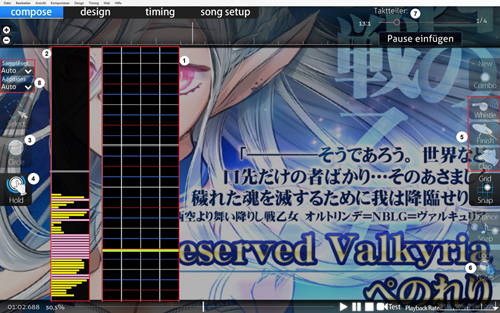 Mania Editor
Mania Editor
Basics
Song Setup
Alright! Let's drag the .mp3 of the song we want to map into osu! and a new map will be created automatically. Whenever you create a map for the first time in the editor, the song setup will open automatically.
General
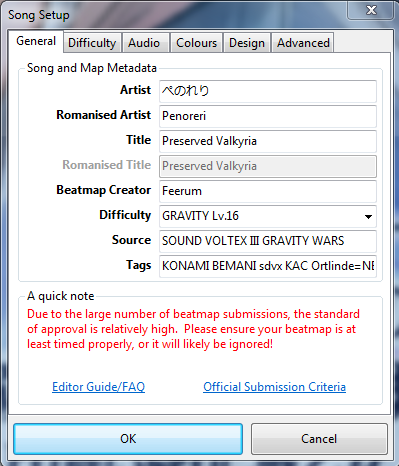 Song Setup
Song Setup
| Name | Description |
|---|---|
| Artist: | Here you'll have to add the original name of your songs Artist. No matter if it is Japanese, German or Russian. If the name of the artist has at least one special character you must add it here! As an example: If your artist name is "Die Ärzte" you must add it here because of the "Ä". |
| Romanised Artist: | Here you have to add the romanised artist name, which translates to the original artist name in Roman (Latin) script. With our example used earlier, it would be "Die Aerzte" because the "Ä" is translated to "Ae". If your artist name does not include any special characters in its name, this field will be filled out automatically. |
| Title & Romanised Title: | Exactly the same thing as with artist, but with the title of the song. |
| Beatmap Creator: | This field is automatically filled out with your name when you are signed in into osu!. If you are not online at the time of creating the beatmap, add your name there. |
| Difficulty: | Ranking Criteria Difficulty Naming Rules You specify the difficulty's name here. As a guide, the standard difficulty names for osu!mania are "Easy", "Normal", "Hard", "Insane" and "Expert". If your song is from an other game you can use the difficulty names of that game! For example Sound Voltex, which uses the following names for their respective difficulties: "BASIC", "NOVICE", "ADVANCED", "EXHAUST", "INFINITE", "GRAVITY". For custom names, refer to the ranking criteria linked above. |
| Source: | Here, you have to add where your song comes from. Is it from another game? Or an anime? Perhaps a TV-show? Add it here! For example: If your song comes from Sound Voltex, you have to add it here. Keep in mind that it has to be the exact name of the game! |
| Tags: | You can add additional information about your song here. For example, album names or producers. Everything that helps to find your song in the beatmap listing. You also have to add the names of every osu! mapper who made a difficulty in your mapset as well. Tags are separated by spaces. |
Difficulty
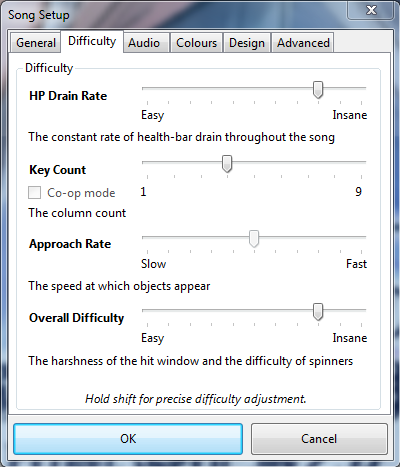 Difficulty tab
Difficulty tab
| Name | Description |
|---|---|
| HP Drain Rate (HP): | A higher value means a more punishing drain and a lower recovery, vice versa. A commonly used HP value would be 7 Note: Only 50 or Misses will drain HP |
| Key Count: | Here you have to set the key count in which you want to map. In this Guide I will use 4K. Note that only 4K, 5K, 6K, 7K, 8K and 9K maps are rankable. The checkbox "Co-Op" can be selected when you choose 5K and above, doubling the keycount. This allows you to play with a friend on one keyboard. |
| Approach Rate: | This point is not used in osu!mania and you can ignore it. |
| Overall Difficulty (OD): | OD changes the hit error range of all judgements except 300g. It is recommended to use lower OD for maps that are Long Note oriented, vice versa for Note oriented maps. |
Design
 Design tab
Design tab
| Name | Description |
|---|---|
| Countdown: | Here you can set a countdown for your map. It is not recommended to enable it. |
| Widescreen Support: | This box should only be enabled when your map has a widescreen storyboard. |
| Display Epilepsy Warning: | Should you use a storyboard with rapidly flashing lights, it's very important to enable this box! This warns the player about the storyboard so he can disable it or increase the Background Dim. |
| Letterboxing During Breaks: | Letterboxing shows little boxes at the top and bottom of the screen while in a break. |
Advanced
 Advanced tab
Advanced tab
| Name | Description |
|---|---|
| Stacking: | This point has no effect for osu!mania so no need to change anything here. |
| Allowed Modes: | With this point, you change the mode of the editor to the one you want to use for your map. This guide is about osu!mania so we use "osu!mania" of course. Should you choose "All", your editor will be set to osu!. Changing this option while in an existing osu!mania map will overwrite the map. |
| Use special Style (N+1 style) for osu!mania: | If you map in a keymode which uses a special key (6K and 8K) you can enable this point. This allows the player to swap the special column to their left or right depending on their settings. Known in "BMS" as the "Scratch Column", it is commonly used in 7+1K (8K) osu!mania. Mapping 7+1K is akin to mapping a 7K map, but an extra special column is generated for the mapper's discretion. |
The point Colours is not used in osu!mania so we don't need to change anything there.
The point Audio will be explained in the part "Hitsounds"
Timing
Once we finished our song setup we need to time our song. The timing set must be accurate to the song's beat, else it'll be hard to map accurately.
Finding the BPM
First you need to listen closely to your song to get a feeling of the rhythm. Once you think you can hear the rhythm, start pressing "T" to the beat until the editor displays a value. You can tap longer to get a more accurate BPM, but most songs have integer BPM values, that is, they don't have decimals.
There should be a ticking sound indicating the BPM set, if it's not present, check if your Effects volume high enough.
Verifying the Offset
Most of the time, your offset will be slightly off, that is, the ticking will sound consistently late, or early. Nudge the value until it sounds perfect on the beat.
Verifying the BPM
Usually, the initial BPM found will be slightly off, you will need to verify the BPM is correct.
Note that bad offsets are different from bad BPMs.
For inaccurate BPM values, the ticking will sway it gets more prominent the further away you get from the red line in the timeline (at the bottom of the editor). This is a telltale sign that your BPM is inaccurate. Try adjusting it by +1 or -1.
If all else fails, you can ask for help in the #osu or #osumania channel.
Finding the First Offset
The first offset is the first beat of your current BPM. Go to the point of your song where you can hear the first beat, press F6, click on the timing point and press "Use current time". Now the timing point should be on the current offset, the first beat.
Should it be right, your song is finally timed!
MixMeister BPM Analyzer
I also would like to show you a little program that can be really helpful to find the right BPM really fast. It is called MixMeister BPM Analyzer. This program will show you the average BPM of your song. It has just one weak point. It can not show you multiple BPMs. It will show you the average BPM of all BPM points in your song. To say it simple: It helps with single BPM only. You can search for it on Google or just click here. Don't try to use it to time every map of you. You will never learn how to time songs when you let this program time everything for you. Use it to compare it with your BPM to check if you got the right one!
Multiple BPMs
A lot of songs don't have a constant BPM. For those, you need to add another BPM point on the point of change.
Go to the point where the BPM changes, press F6 to open the Timing panel, add another timing point by clicking on the green "plus" and adjust it to the BPM change while listening to the metronome again. You can also press Ctrl + P to set a BPM point at the time stamp you are currently at. Do this for every BPM change in your Map!
Timing Setup Panel
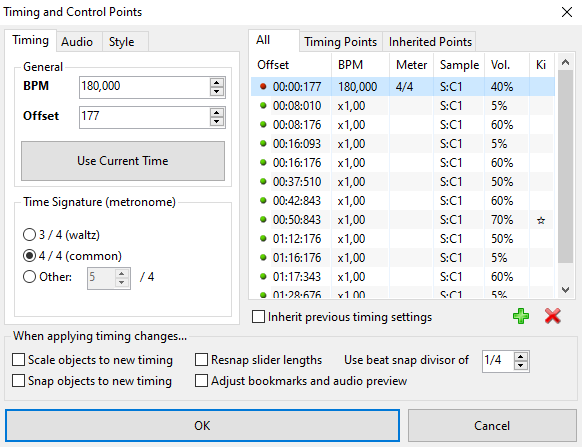 Timing Setup
Timing Setup
| Name | Description |
|---|---|
| Timing Point: | The timing point or "Red Line" is there to time your song. Without it you can't start mapping. Refer to above on steps to Timing your song |
| Inherited Point: | The inherited point or "Green Line" is used to add "effects" to your map. With these, you can change the volume, the sample set, the slider velocity (SV) and you can add a Kiai-Time. |
| Kiai: | The Kiai can be selected in "Style" and can be added between two inherited points. The Kiai Time is normally used in the chorus of your Song. It'll spawn star fountains on both sides of the screen and is used to emphasise a section of the map. |
Pattern
Once you finally have the right timings in your map it's time to start mapping. Patterns are like building blocks to the map, it is essential to know their names and their purposes. I will add a screenshot for each and every pattern with a short description for what they are and when you should use them.
Long Note
The LN is the "Slider" in osu!mania. Using LNs are the best way to represent long sounds in your song. There are lot of ways to use a LN which I will explain in another part of this guide.
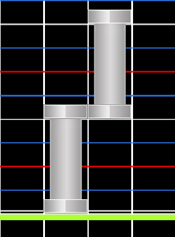 Long Note
Long Note
Chord
In the screenshot I have used a two note chord. Chords mean more than 1 note. "Doubles", "triples" or "quads" fall into that category. It is used to emphasise strong sounds in your song like heavy drums or cymbals.
If you are planning to rank your map, you can use up to six notes! Anything more is against the Ranking Criteria.
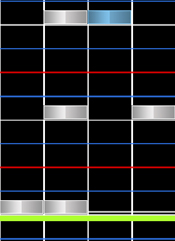 Chord
Chord
Burst
Bursts are quick bursts of notes. They are not necessarily 1/4, but is defined by a sudden increase in density for a short period of time.
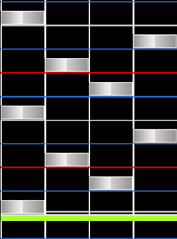 Burst
Burst
Staircases
The staircase is mostly used for fast sounds. Note that some stairs get very hard to execute after a certain BPM, this is mainly due to the jacks formed on columns 2 and 3.
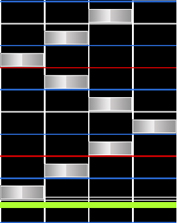 Staircases
Staircases
Roll
Rolling is similar to Staircases. Usually rolls are delimited by a repeating pattern of 4 or more notes, but more generally, it's notes going in a certain direction. A 1234 is a roll and a 1324 is a split roll.
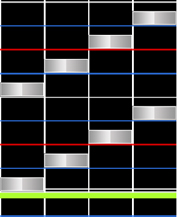 Stair
Stair
Jackhammer
Also known as a Jack. It is recommended to use jacks for two sounds that sound exactly the same. Jacks can scale in difficulty quickly when overused. It is recommended to avoid too much of these unless you're certain.
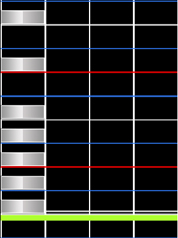 Jackhammer
Jackhammer
Shield
The shield can be recognised by the fact that its always note right before or after a LN.
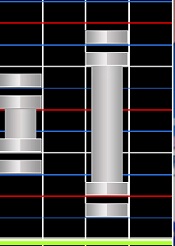 Shield
Shield
Chordjack
The chord jack is a combination of the jackhammer and the chord. The way to use it is the same as for the jackhammer. For same sounds, just that you use these as chords for heavier sounds.
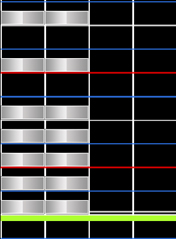 Chordjack
Chordjack
Trill
The trill is used for two really fast changing sounds in your song. In the screenshot we see the one handed trill, however you can also use columns 1 and 3 instead for a two handed trill.
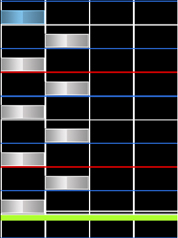 Trill
Trill
Chordtrill
The chord trill can raise the difficulty of your map quickly. Like the trill, the chord trill is used to emphasise two much louder sounds that change really fast. A simpler alternative would be using 12 and 34 chord trills instead.
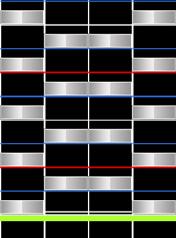 Chordtrill
Chordtrill
Jumpstream
Jump is a 2-note chord, hence jumpstream is a 2-note chord stream.
A jumpstream can be used to layer strong sounds between a constant 1-note stream, using a 2-note chord whenever feasible.
There a lot of different ways to map jumpstreams. In the screenshot we can see a really safe way to map it because there no 1/2 triple jacks in it.
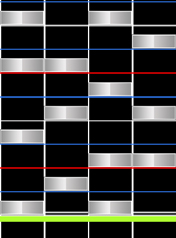 Jumpstream
Jumpstream
Okay! These are some of the different patterns you can use in your song! However, there are still many more configurations of patterns not covered in this guide. Many combinations work well together. Try to experiment these patterns in your song and I'm sure you can find a good mix of them for your song!
Mapping
After we finally know which patterns we can use and how they are called we can start with the mapping. Just drag the song you want to map into osu!, fill out the song setup up and add the timing! If your first tries look kinda strange or you don't like it, don't give up! No one is born as a master. Testplay your map as often as you can and when it is finished try to get as much feedback as possible! Ask friends that play osu!mania, ask in #osumania or write directly to some player in-game and ask for feedback. It really helps a lot when you use the 25% playback rate while mapping. Alright, let's go! In this part I would like to explain what exactly you should have an eye on while mapping an Easy/Normal/Hard or Insane difficulty.
Notice: Keep in mind that everything what I will write from here is just a guideline and you should not take this as actual rule. You don't need to follow this guideline verbatim.
If you want to rank your beatmap there some points you have to take note of.
First: You need a full spread in your beatmap. An osu!mania beatmap needs usually 3 difficulties or more. An Easy/Normal, a Hard and a Insane one. Of course you can decide for yourself if you want an Easy or Normal but it is best to have both. However you are not forced to have an Easy difficulty in your Mapset. The osu!mania Ranking Criteria says that your lowest difficulty has to be below 2*. That means you can have a Normal as the lowest as long as it is below 2*. Maps for approval are not affected of this rule!
While creating a full spread, it is very important to look at the pattern spread, not at the star rating! It can happen that the star rating becomes really high just because of one really dense part in your map. Osu!mania has a really helpful tool for mapping different difficulties when you already have one ready. As an example: You already have the Hard difficulty for your mapset finished and now you want to map a Normal one. Open the new difficulty, click on "File", then on "Open Difficulty" and then click on "For Reference". Now choose the Hard difficulty. Now, a second mapping field will appear next to your current mapping field. It's the Hard difficulty. It shows you exactly how you have placed the pattern there and you can take this as reference on how to map the Normal difficulty!
Here are also some general tips for mapping:
Be consistent! What does that mean? Do not use different kinds of patterns for exactly the same sound in your map. As an example; if you use a chord for drums or snare, keep it like that! Do not change it to a single note later on. Consistency of the patterns is one of the most important aspects of osu!mania mapping. It just feels wrong when playing if you use different amounts of notes for the same sounds.
Now I'll explain the general guidelines on what to chart for particular difficulties, ranging from Easy to Extras
Like I said this is just a guideline and you don't have to follow these 1:1.
The "Easy" difficulty: Like the name already says, we are mapping the easy difficulty here. And this it should be: Easy to play! We want to introduce the newer players to osu!mania and he should learn the basics. That's why we want to keep our difficulty as simple as we can. We don't use any 1/4 pattern, even ½ pattern should be used carefully. Use chords only to emphasise the beginning or the end of a part with a heavy cymbal. Make sure you always try to balance the hands very well. Use a lot of LNs for the long sounds in your song and to map heavy 1/4 sounds and above. If you want to use chords for example in your kiai, make sure the player has enough time to react. That means give him 1/1 beat time! In most songs the second down or main beat is always louder than the first one, with heavy drums, kicks or clap sounds. These you could map a chord while you use a normal note for the quiet sounds. But still: In the best case just use normal, single notes. Also do not use single notes while having a LN! The player should first learn how to handle a LN and how to release it at the right time. If you really want to use single notes during a LN you should watch out that the single note is on the other hand. Means, when you have mapped a LN on the right hand, the single note must be pressed with the left hand! Also don't forget: If you want to add an easy difficult to your song you should try to keep it below 1,5* to have the easy icon.
The "Normal" difficulty: Now that we know how to map an easy difficulty, we can raise the density of the notes for the normal difficulty a little bit. We can use more 1/2 patterns now, but we should try to avoid using 1/4 patterns or just use them really carefully. In the best case only when your song has a really low bpm or only really short stairs. Also we can use more chords now. If you have a heavy snare drum or a heavy cymbal in the middle of the part we can map this with a chord to emphasise these. Also, we can use single notes during a LNs but please try to use different hands like explained in the easy difficulty! Should you have more notes than one during the LN it's okay to have some on the same hand as the LN, but most of them should still be played with the other hand! Here we should definitely map the kiai with chords and normal notes like already explained in the easy, but do not overuse it. Depending on the bpm of your song you can also add 1/2 normal notes here. But do not forget: The player just learned the basic pattern and you should not overdo it! A also good point for a normal difficult is to follow the PR (pitch relevancy) with your notes. Higher sounds can be mapped on the right side, deeper sounds on the left side of the play field.
The "Hard" difficulty: In the Hard difficulty we can start to add more complicated patterns since the player should have learned the basics from easy and normal. We can start to add longer 1/4 bursts and stair patterns, we can also start to use 3-note chords for heavy cymbals at the end or at the beginning of a part. Also, depending on the bpm and the part of your map, we can use short jump streams but make sure they fit to the part you currently map. When the song gets more hectic and faster, it's the perfect time to add such a jumpstream. You can start to use short jack patterns here as well. What you should avoid are chord trills. Chord trills have a really high pattern density which may result in a very high star rating. You can of course use short triples of chords, these should not have a big impact on the star rating. The kiai should be the most dense part of your map if possible. Also, you can try to combine more LNs and ¼ single note patterns. Try to combine different lengths of LN patterns at the same time! It can give your map a special feeling by using more than one LN at the same time. But be very careful here. Make sure every LN follows a sound! Do not add these "randomly" into your song just because you think it could play well. Depending on the BPM it's also okay to add short 1/6 or 1/8 stair patterns. But use these carefully. Only when the song provides enough for these. The 1/6 burst should not be longer than a 1/2 beat and the 1/8 not longer than 1/4 beat! The lower the bpm of your song is, the longer these burst patterns can be.
The "Insane" and "Extreme" difficulty: Now we focus on the insane and extra difficulties. Again, we raise the density of the pattern and start to use even more complicated patterns! You can now use all kinds of pattern and try to combine them. Also, you can now use long 1/8 patterns as well as chord trills! An insane and extra difficulty is mostly for more experienced players, so you should try to make a really nice to play and still exciting difficulty. Try to combine jumpstreams with trills and heavy chord mashing. You can now use 3-note chords for more than just emphasising the ending of a certain part in your song. But keep in mind: Should you plan to add another difficulty like an extra difficulty, you should not go to the limits! You should leave some space to make an even harder difficulty. I can't tell much since you just have to create a harder difficult than the hard in a good spread. If you plan to add an extra difficulty you can go to the limits of the song. You can use heavy jumpstreams together with heavy chordmash. You can use 3-note chords in jumpstreams between two-note chords. You have to try out what's the limit of the song. But take note of the following: A guideline says that you must be able to pass your own difficulties and I have to agree with this point. If you really want to create a good and playable insane/extra difficulty you should know how they play and for this you have to be able to pass them.
Hitsounds
You have placed your first notes and you like it? Or you Or you may have even finished a full difficulty or spread? Excellent! But something is missing, right? Yes! The Hitsounds.
Hitsounds are important in every game mode. They give feedback when pressing a note so the player knows what he just hit. Also having different hitsounds in your map can give it a special feeling because the song sounds different all of the sudden, maybe even better than without hitsounds! Osu!mania has two different ways to hitsound.
First, there is the normal way that uses the samples and effects provided by the game itself, like whistle/finish and clap. The other way is via the sample menu that you can open withCtrl + Shift + I. That sample menu is especially important for keysounding that's why I will explain it later!
For now, we want to focus on the normal way of hitsounding.
First you have to decide; do you want to use the default hitsounds that osu! gives you or do you want to add custom hitsounds?
If you want to use the default one you don't really need to change a lot. Everything you need is to decide which sample set you want to use as a default. Go into the Timing Setup Panel and change your timing point to the sample set you want to use. Osu!mania usually uses "soft" as default because the hit-normal isn't that loud.
You can always change the sample set for a whole part by selecting all notes and changing it to the desired sample set or you can add an inherited point (green line) and change the whole part to the selected sample set until the next inherited point. Now you just need to add the hitsound you wish! You can choose between Finish, Whistle and Clap. All of these effects sounds different when you change the sample set. Try around for a little bit and i'm sure you can find the perfect one for your song!
Now I will explain how to add custom hitsounds to your beatmap.
First you need the hitsounds you want to add. These have to be a .wav file. You can not use hitsounds in a .mp3 or .ogg format, because this is unrankable. Also you have to make sure your used hitsounds are rankable! Means, they have to be at least 100ms long and the hitsound must have an acceptable range of delay under 5ms. In the best case, your hitsound has absolute no delay, you can always cut the delay with programs like Audacity. Also it's not allowed to use silenced hitsounds in osu!mania. Every pressed note has to give a feedback. Once you have the custom hitsounds you want to add you need to rename them. When you want to hitsound the usual way your hitsounds must have following one of the names:
Hitsound List
Following hitsounds can be changed in the song folder:
- normal-hitnormal
- normal-hitwhistle
- normal-hitfinish
- normal-hitclap
- soft-hitnormal
- soft-hitwhistle
- soft-hitfinish
- soft-hitclap
- drum-hitnormal
- drum-hitwhistle
- drum-hitfinish
- drum-hitclap
You can add more than just these! You can name your hitsounds as well! As an example "soft-hitnormal2". You need to change the sample set you want to use in the Timing Setup Panel.
Also notice: The "xxx-hitnormal" is the hitsound which gets played when you don't give the note a specific hitsound. For example; when you change the "soft-hitnormal", every note in your map that has the soft sample-set active will have this hitsound! Be careful when changing them.
Once you have added your custom hitsounds you need to activate them!
For this, we open the Timing Setup Panel in the editor and mark all points. Now we go into "Audio" in the Timing Setup Panel and change the Sample Set to "Custom 1". That's it!
All your hitsounds in sample set 1 are now activated! Should you use another sample set, you choose the third point and choose the sample set you also chose for your hitsounds.
After you finally have your hitsounds, don't forget to activate "Lock Notes". That way, no notes can be moved when your hitsounding your map. Hitsounding doesn't take a lot of time at all. You can choose one or more notes at the same time, change the sample set on the top-left of the screen and add the effect on the right side. Now all these notes have a hitsound!
You don't even have to select all of this by hand. You can also change the sample set, the additions and the effect with hotkeys! Once you know which hotkey is for what hitsounding becomes an extremely easy task! Here's the list of hotkeys you can use for hitsounding your beatmap:
Hitsound Hotkeys
Shift+Qchanges the Sample set to "Auto"Shift+Wchanges the Sample set to "Normal"Shift+Echanges the Sample set to "Soft"Shift+Rchanges the Sample set to "Drum"CTRL+Qchanges the Additions to "Auto"CTRL+Wchanges the Additions to "Normal"CTRL+Echanges the Additions to "Soft"CTRL+Rchanges the Additions to "Drum"Wgives your note the effect "Whistle"Egives your note the effect "Finish"Rgives your note the effect "Clap"
Note: Of course you can add more than one effect on a note!
What I want to mention: Never hitsound more than one note in the same chord with the same hitsound! Please keep in mind that every note that gets played also plays the hitsound. When you have two notes with the same effect, the effect will also be played twice. This is just too loud.
Hitsounding may take some time but like I already mentioned it's important for the beatmap. Once you get used to it, hitsounding will go really fast!
Advanced Knowledge
In this part I would like to explain more details of osu!mania mapping like keysounding, SV changes and pitch relevancy. Also, together with the community I want to explain different mapping styles here. The osu!mania community consists of players from different VSRG's like o2 jam, Stepmania and BMS. All these games have a special mapping style.
Pitch
Mapping to the pitch can lead to a fun to play map, especially in osu!mania!
Basically it's not even that hard, you place your notes to the pitch like on a piano, lower pitched sounds are mapped on the left side, the higher sounds on the right side. This is used more frequently in the higher keycounts, (7K, 8K, etc.) where you have more possibilities because of the wider playfield and more columns.
Of course you shouldn't map the whole song to the pitch because this can cause some balance problems in your map.
What you always can try is to map the calm parts in your map to the pitch, especially when you use mostly single notes in that part. Also, when your song has audible instrumental pitch changes, you should try to follow it.
Of course you don't need to follow the pitch in your map but you can see it as a "little extra" that can make your map more exciting to play.
Slider Velocity (SV)
The Slider Velocity acts a bit different in osu!mania; it changes the speed, at which the notes scroll downwards. Higher slider velocity means that the notes fall faster, lower Slider Velocity means the notes fall slower.
This is mainly used to emphasise specific part of the maps! For example; when the song gets calm and slower, you can use a low slider velocity, to make the map fit to the mood of the song. But when the song has a few, short and fast breaks, you can use higher SV to make the map more exciting, that way, it fits the song even better!
Also you need to add SV changes to your map when your song has multiple BPM changes. As an example: If your song has a BPM change from 150 to 200, the scroll speed of your notes will also get higher! To prevent this, we need to add an SV point at the BPM change to adjust the scroll speed to the average BPM.
The formula to adjust the SV to the BPM is: SV = Mode BPM / Current BPM
The mode BPM of your map is always the number in brackets that you can find in the song select menu on the top-left beside the BPM.
You take this number and divide it by the current BPM. What you will get is the SV you need to set with a Inherited Point at exactly the same timing as the BPM change.
Design/Mapping Styles
As mentioned before, the osu!mania community consists of players from different VSRGs so they are used to having different mapping styles as well.
While every person who's mapping has his own style, there some basic features on which you can recognise the other games mapping styles.
Stepmania Style
Stepmania has one of the largest communities for VSRG Games. Therefore it also has a large mapping community!
Stepmania style consists, besides of the personal style of every mapper, basically out of two different mapping styles. The NB5/Yolomania 4 and the DCP/LCP style.
The DCP/LCP style emphasises the musical relevancy through mapping techniques like pitch relevancy and jack theory. (The jack theory is basically creating jacks to emphasise a certain instrument like a cymbal crash). The DCP/LCP charts are more appreciated by other charters than the players because they focus mostly on musical relevancy and not so much on playability.
The yolomania style relies more on pattering than anything else. It cares more about creating good playable charts for the player and the community. While it still uses the concept of pitch relevancy, it has not the highest importance.
Generally said: DCP-Style charting cares more about the songs rhythm and its pitch and yolomania-style cares more about the players and how they'd respond to certain pattern choices.